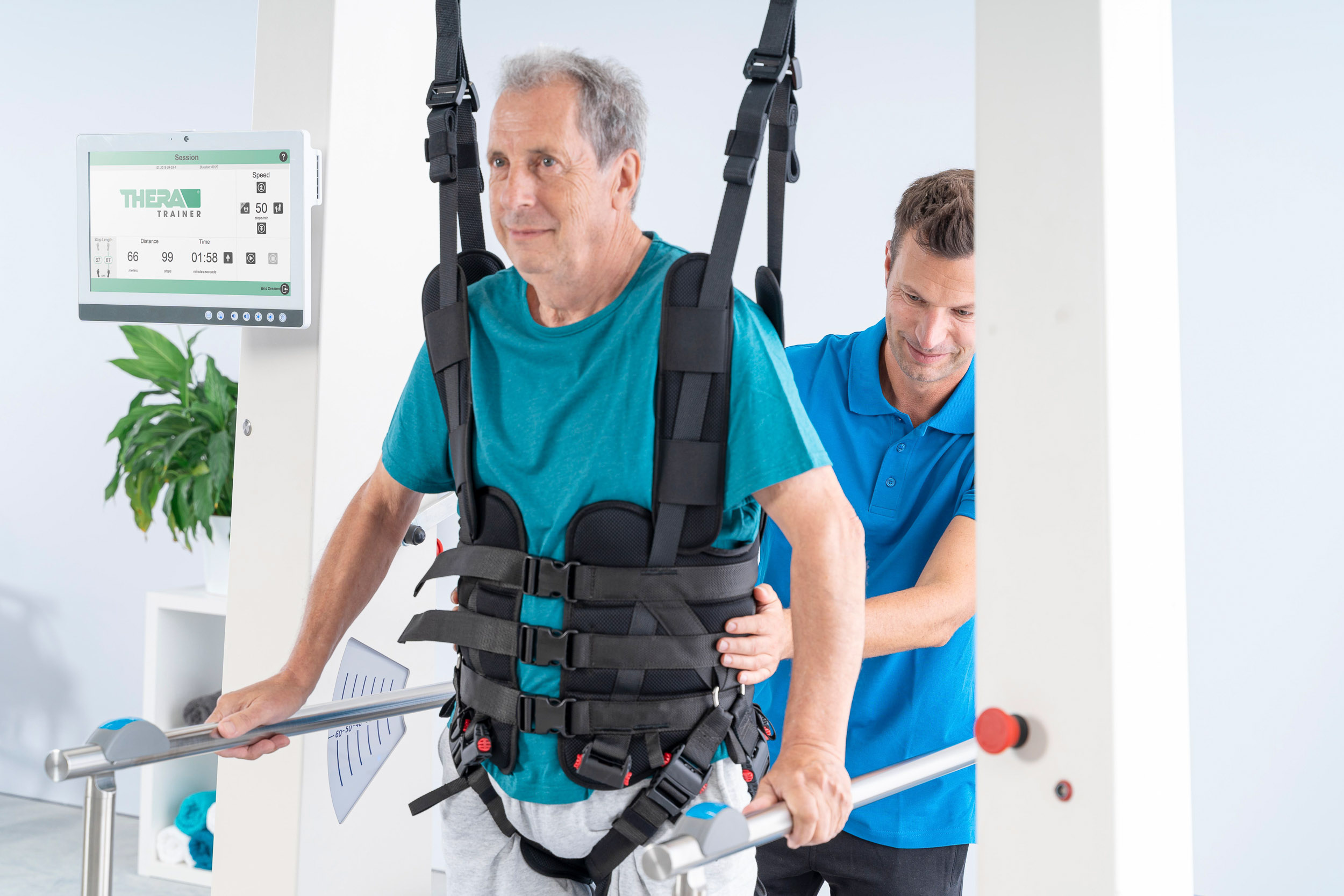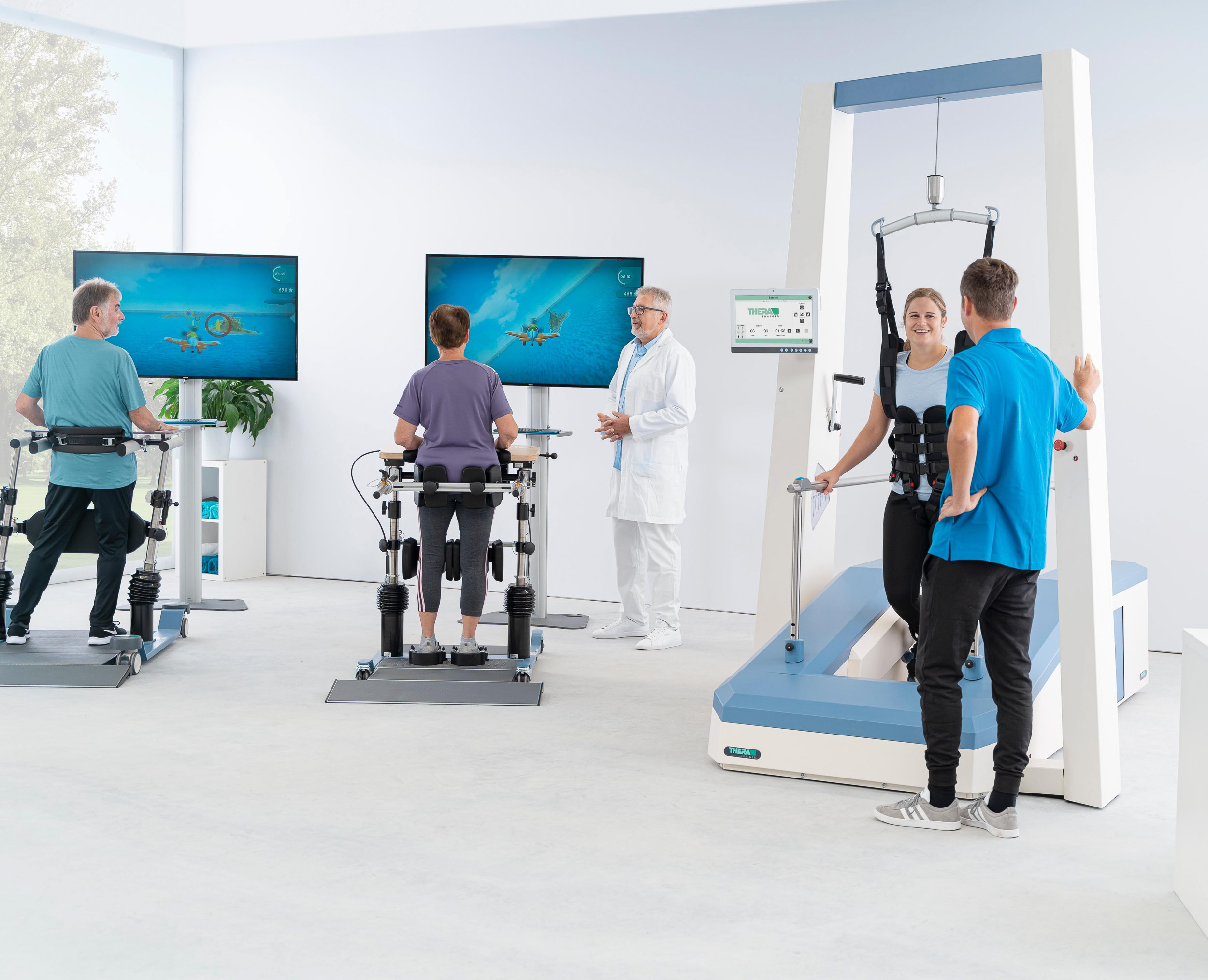
THERAPY Magazin
Standing and walking combined
Discover how combining robot-assisted gait training with balance therapy enhances mobility, reduces fear of falling, and supports neuroplastic recovery in stroke patients.

Jakob Tiebel
Health Business Consultant
The influence of robot-assisted gait training on balance and fear of falling in stroke patients
The combination of standing and gait trainers offers stroke patients a varied training regime with multiple stimuli.
Combined therapeutic approaches that incorporate device-based balance and treadmill training open up new perspectives in stroke rehabilitation. The combination of standing and walking offers patients multiple sensory and motor stimuli, which encourage neuroplastic processes and accelerate functional progress. At the same time, modern therapy equipment allows for precise measurements and individual adjustments, enabling long-term improvements in mobility and quality of life.
A study published in the American Journal of Physical Medicine & Rehabilitation by Gunduz and colleagues from Istanbul examined the effectiveness of a combined training approach that combines robot-assisted gait training with balance training compared to balance training alone in stroke patients.
The intervention extended over a period of five weeks, during which 42 patients were divided into two groups. The intervention group underwent combined training, consisting of balance exercises and robot-assisted gait training, while the control group received conventional balance training only. The study objective was to evaluate improvements in balance, fear of falling, as well as the function of the lower extremities.
Balance was analysed with an app that recorded standing and sitting times as well as directional sways (anterior, medial, lateral) during walking. In addition, the Berg Balance Scale, the Timed Up and Go Test, the International Fall Efficacy Scale and the Fugl Meyer Assessment Test were used for the clinical evaluation of the primary and secondary endpoints.
The results of the study show that the group with combined training achieved significant progress in directional sways, standing and sitting times, balance, as well as fear of falling. The group with balance training alone also recorded improvements, particularly in relation to mobility and function of the extremities. In direct comparison, combined training proved superior in terms of standing and sitting times, while traditional balance training achieved better results in limb function.
The study suggests that an integrative approach, combining robot-assisted gait training with balance training, is particularly effective for improving balance and reducing fear of falling. The results highlight the usefulness of such an approach in subacute and chronic stroke rehabilitation, as it meaningfully extends the advantages of the individual methods.
A study published in the American Journal of Physical Medicine & Rehabilitation by Gunduz and colleagues from Istanbul examined the effectiveness of a combined training approach that combines robot-assisted gait training with balance training compared to balance training alone in stroke patients.
The intervention extended over a period of five weeks, during which 42 patients were divided into two groups. The intervention group underwent combined training, consisting of balance exercises and robot-assisted gait training, while the control group received conventional balance training only. The study objective was to evaluate improvements in balance, fear of falling, as well as the function of the lower extremities.
Balance was analysed with an app that recorded standing and sitting times as well as directional sways (anterior, medial, lateral) during walking. In addition, the Berg Balance Scale, the Timed Up and Go Test, the International Fall Efficacy Scale and the Fugl Meyer Assessment Test were used for the clinical evaluation of the primary and secondary endpoints.
The results of the study show that the group with combined training achieved significant progress in directional sways, standing and sitting times, balance, as well as fear of falling. The group with balance training alone also recorded improvements, particularly in relation to mobility and function of the extremities. In direct comparison, combined training proved superior in terms of standing and sitting times, while traditional balance training achieved better results in limb function.
The study suggests that an integrative approach, combining robot-assisted gait training with balance training, is particularly effective for improving balance and reducing fear of falling. The results highlight the usefulness of such an approach in subacute and chronic stroke rehabilitation, as it meaningfully extends the advantages of the individual methods.

The integration of equipment such as standing and walking trainers into defined therapy pathways creates a combined training approach.
Comments
The results of the study illustrate the potential of combined approaches in stroke rehabilitation, particularly through the connection between robot-assisted gait training and balance training. This approach demonstrates an effective way to specifically address particular motor deficits, while simultaneously improving balance and fear of falling. The intervention offers a useful addition to existing rehabilitation concepts by integrating static and dynamic training stimuli.
A key benefit of combined training is the possibility of promoting different motor skills simultaneously. Balance training supports postural control and stability, while robot-assisted gait training addresses mobility and implicit motor learning through repetitive movement patterns. This combination creates different sensory and motor stimuli that support the neuroplastic adaptation of the central nervous system, thus enabling functional restoration at multiple levels.
The standardised procedures and precise control through robot-assisted technologies are an additional benefit of the intervention. They enable a differentiated adjustment of training intensity to the individual needs of patients and, through integrated measurement systems, provide a reliable basis for progress documentation and adaptation of therapy. This structure can be particularly advantageous in the sub-acute and chronic phases of rehabilitation in order to address patients’ deficits in a targeted and efficient manner.
In summary, the study provides evidence-based indications of the effectiveness of a combined training approach and its contribution to improving balance and reducing fear of falling in stroke patients. The results underline the value of a structured integration of modern technologies into rehabilitation practice.
The results of the study illustrate the potential of combined approaches in stroke rehabilitation, particularly through the connection between robot-assisted gait training and balance training. This approach demonstrates an effective way to specifically address particular motor deficits, while simultaneously improving balance and fear of falling. The intervention offers a useful addition to existing rehabilitation concepts by integrating static and dynamic training stimuli.
A key benefit of combined training is the possibility of promoting different motor skills simultaneously. Balance training supports postural control and stability, while robot-assisted gait training addresses mobility and implicit motor learning through repetitive movement patterns. This combination creates different sensory and motor stimuli that support the neuroplastic adaptation of the central nervous system, thus enabling functional restoration at multiple levels.
The standardised procedures and precise control through robot-assisted technologies are an additional benefit of the intervention. They enable a differentiated adjustment of training intensity to the individual needs of patients and, through integrated measurement systems, provide a reliable basis for progress documentation and adaptation of therapy. This structure can be particularly advantageous in the sub-acute and chronic phases of rehabilitation in order to address patients’ deficits in a targeted and efficient manner.
In summary, the study provides evidence-based indications of the effectiveness of a combined training approach and its contribution to improving balance and reducing fear of falling in stroke patients. The results underline the value of a structured integration of modern technologies into rehabilitation practice.
Ambulante Rehabilitation
Fachkreise
Gait
lyra
Produkte
Science
Stationäre Rehabilitation
THERAPY 2025-I
THERAPY Magazine

Jakob Tiebel
Health Business Consultant
Jakob Tiebel is OT and studied applied psychology with a focus on health economics. He has clinical expertise from his previous therapeutic work in neurorehabilitation. He conducts research and publishes on the theory-practice transfer in neurorehabilitation and is the owner of an agency for digital health marketing.
References:
- of Falling in Patients with Stroke: A Randomized Controlled Clinical Trial. Am J Phys Med Rehabil. 2024 Dec 3. doi: 10.1097/PHM.0000000000002674. Epub ahead of print. PMID: 39642346.
You need to load content from reCAPTCHA to submit the form. Please note that doing so will share data with third-party providers.
More InformationYou are currently viewing a placeholder content from Turnstile. To access the actual content, click the button below. Please note that doing so will share data with third-party providers.
More Information